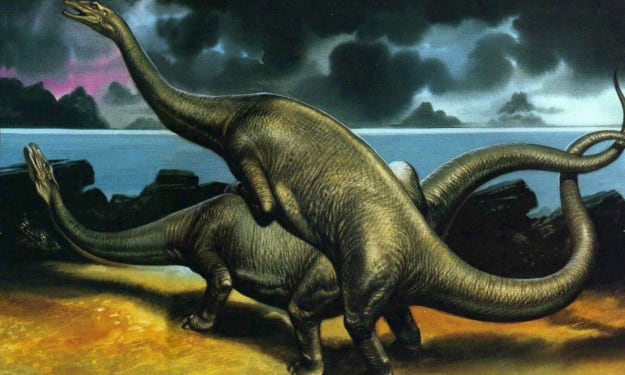Ben Bova Interview
Ben Bova shares his thoughts on OMNI Magazine, Bob Guccione, and the future of science fiction publications.

"Don't ask your readers to admire your words when you want them to believe your story." Science Fiction author Ben Bova realized that the general rules of science - don't add an experiment to an experiment, and don't make things overly complicated - also applied to science fiction. His theory certainly brought him success. Starting out as a technical writer for Project Vanguard in the 1950's, Ben Bova went on to become a successor to John W. Campbell as editor of editor of Analog Science Fact & Fiction where he won six Hugo Awards. Throughout his career he authored over 120 books on science fact and science fiction, worked as editorial director for OMNI magazine, and was president of both the National Space Society and the Science Fiction Writers of America. He has appeared as the Guest of Honor at the Florida convention Necronomicon on two separate occasions, and in 2000, he attended the 58th World Science Fiction Convention as the Author Guest of Honor.
To honor the high-level legacy of OMNI, we spoke to Ben Bova about what it was like to run the ship at the greatest science magazine of all time, publishing some of the greatest science fiction writers in OMNI, working with Bob Guccione, and OMNI's place in the annals of science fiction.
You went to OMNI after seven award-winning years editing Analog. How did the two publications differ?
Bova:Analog was published in those days by The Condé Nast Publications, Inc., a major magazine house that published Vogue, Glamour, Mademoiselle, House & Garden, etc. They had acquired Analog when they bought out Street & Smith, around 1960. The management of Condé Nast didn’t know anything about the science fiction magazine except that it made a small profit every month, and it was regarded as the leader in its field. They just let John W. Campbell Jr. run the magazine as he saw fit. Campbell, of course, was a giant in the field, and had discovered most of the major science fiction writers of the time. I was picked to take over the magazine’s editorship when Campbell unexpectedly died, and tried to continue I his tradition. My only staff was Katherine Tarrant, who had been Campbell’s assistant since he first took over the editorship in the mid-1930s. I had an art director, and one of the circulation department’s senior men handled Analog’s circulation business. I made all the decisions, with no one looking over my shoulder.
Omni, of course, was a very different affair. We had an editorial staff, an advertising staff, and a circulation staff. It was a major magazine, breaking new ground in the industry. And it was, for me, a dream come true: a big, national (even international) magazine, heavy with advertising, read by millions every month. There were always issues of one kind or another with the staff, but they were minor. We worked together quite well, actually.
You once pitched a magazine of science fiction and nonfiction, Tomorrow Magazine, to Condé Nast: did that vision turn into your work at OMNI?
Bova: I felt that Analog, good as it was, only spoke to the relatively small science fiction community. I proposed a major national magazine that focused on the future, both with fiction and fact articles. The management heard me out, but decided that they didn’t know enough about the subject matter to invest in a major effort. They knew the women’s magazine market, so they launched instead Self magazine, which had done quite well for them.
How much freedom did you have at OMNI?
Bova: I had a very wide field of operations. Kathy Keeton was the actual publisher of Omni, the idea for the magazine was hers. She was in the office every day, but she hardly ever interfered with editorial decisions. She made suggestions aplenty, and many of them were good. Those that weren’t, we discussed openly, and she almost always gave in to our editorial opinions. As long as the magazine sold well, everyone was happy. And Omni did sell spectacularly well, thanks to its editorial content, its visual quality, and a very talented circulation department.
Kathy Keeton was the de facto publisher of the magazine. Bob Guccione was the boss, but he usually stayed clear of the editorial process. He was more interested in the magazine’s visual appeal. Both Kathy and Bob were vitally interested in showing the world that Bob Guccione was more than a copycat of Hugh Hefner. Omni broke new ground and succeeded when most of the pundits said it would fail. That made both Bob and Kathy very happy.
What was the tone of “OMNI under Bova”?
Bova: I emphasized that Omni is not a science magazine. It is a magazine about the future. Science magazines came and went: some of our editors had worked at half a dozen different science magazines, all of which folded. I tried to get across to the editorial staff (and everyone else) that the public’s conception of science is that it’s like spinach: good for you but not terribly appetizing. Our approach was to present the future, which is like lemon meringue pie: delicious and fun. Of course most of our nonfiction pieces dealt with science in one way or another. But our approach was to talk about the future; readers swallowed the science because we made it palatable.
Did you feel that you had any peers?
Bova:Omni was sui generic. Although there were plenty of science magazines over the years (most of which failed eventually) Omni was the first magazine to slant all its pieces toward the future. It was fun to read and gorgeous to look at. I don’t think we had any direct competition, although our success prompted other publishers to bring out other science magazines.
How was OMNI perceived in the science fiction community?
Bova: The science fiction community was initially leery of a magazine that included science fiction in its pages but was published by the man who published Penthouse. A large part of my responsibilities was to show the science fiction community that Omni was the real thing. I also worked to convince potential advertisers and overseas publishing houses that Omni was far more than “Penthouse in space.” The fact that our payment rates for fiction were ten times the rates of ordinary science fiction magazines helped to bring the writers to us. But I had to impress on them the fact that Omni’s audience included tons of people who never read science fiction. Our writers had to be able to write for a much more general audience, and eschew the jargon that dedicated science fiction people took for granted, but was unknown to the wider audience. Some of the best-known writers in the science fiction field were not able (or perhaps willing) to do this. Most of them were personal friends. But they couldn’t write for Omni, alas.
What do you think is OMNI's greatest legacy?
Bova: I think Omni’s greatest legacy is that there is a tremendous audience for fiction and nonfiction about science–if it is presented in an attractive, understandable way.
Ben Bova’s Greatest Books:
Ben Bova is considered to be one of the greatest science-fiction novelists of all-time, and for good reason. Often those who write science fiction have an interest in it, but not a background. For Ben Bova, that is not the case. He began working as a technical writer for Project Vanguard in the 1950s, which helped to launch the first United States satellites into orbit, and from there continued to work in various science fields. He would even become President Emeritus of the National Space Society, and he has taken that knowledge of space and science and turned it into 124 books that have developed into a huge fan base for the author.
In this book, the CEO of Astro Corp., Dan Randolph, has a dream of developing energy for the earth through solar satellites. Unfortunately, politicians and oil companies make this very difficult for him. In response, he builds a space plan that reduces travel time and costs, allowing him to build cheap Powersats. Things take a turn when the space plan blows up on re-entry into the atmosphere of Earth, and Randolph believes it may not have been an accident.
Written in 1992, Jamie Waterman is going to be part of the first mission to Mars and even be on the landing crew, much to his own surprise. After decades of preparation, the crew only has a few months to prove that Mars needs more missions to it. Over the course of the book, the explorers go from the highest point on Mars to the lowest, discovering much on the way.
Written in 1985, this book follows an alternative history where the Soviet Union has not collapsed, marking a much different world than the one that we know today.
Published in 1996 as part of The MoonBase Saga, Moonrise is definitively considered one of the best Ben Bova books. This book is set on an old lunar base that is losing a lot of money and is in danger of being shut down by the Board of Directors. It is up to Paul Stavenger, an astronaut and the husband of the Boar CEO, to ensure the base is not shut down and a viable moon colony is built. Unfortunately, not everyone agrees with him, nor approves of his marriage to the CEO of the board.
The second book in The MoonBase Saga, published in 1998, this book follows New Morality, a group of religious zealots who are against nanotechnology and who have the support of many of the Earth’s citizens. Calling it the devil’s work, the nations of Earth ban nanotechnology and only MoonBase remains as the only legal place for the practice. The technology could save the Earth, but the UN complicates things when they send troops to take over the base after independence is declared from Earth. What follows is one of the costliest wars in human history.
Written in 1999 as part of the Grand Tour series of novels, it follows Jamie Waterman on his return from Mars. The public is enraptured with going back to Mars and a millionaire named Daryl Trumball is ready to finance it, if his son can go along on the mission. His reasons are not exactly on the up-and-up, and Waterman is caught between ensuring that the Red Planet is a viable place for a colony, while keeping the planet from being exploited by Trumball.
The first in the Asteroid Wars Series, published in 2001 it follows Martin Humphries as he appeals to CEO Dan Randolph of Astro Corp about his fusion space propulsion design. Randolph, whose company is nearly bankrupt, jumps at the chance at using the new technology but before long he begins to realize he may have made the wrong choice, and the Earth itself could be at risk as a result.
Published in 2000, this book brings us the character of Grant Archer, an astrophysicist who wants to one day create a wormhole using collapsing stars. Sadly, once he graduates from college he must go to Jupiter for four-years of service thanks to the New Morality, the organization calling the shots on Earth. He must spy on the scientists at a station orbiting Jupiter and verify if they have found life living in Jupiter’s clouds. Once at the station, he begins to learn secrets that could change humanity forever.
Following Martin Humphries after he returns from the asteroid belt, the book pits Humphries against Pancho Lane and Lars Fuchs, two individuals who want to cash in on his discovery of water and metal ores in the belt. The three men are pitted against each other, and none of them want to back down. Their fight could have a lasting impact on the fate of the Earth and its hungry need for resources.
After the destruction of a habitat at Ceres, a family is left adrift in a command module for five years around the belt. At the same time, the characters of Dorn and Elverda travel the asteroid belt looking for bodies of those who died in the Asteroid Wars, while pursued by individuals bent on their own destruction. Eventually, all the parties come together through fate at the right moment to restore the hope of humanity.
With a new space habitat launching towards Saturn, everyone is getting prepared to live farther from Earth than has ever happened before. A total of 10,000 people are journeying in the habitat, all exiled by the New Morality from Earth. As the habitat begins its journey, a new society begins to form and before long the inhabitants soon realize that they may all be just a part of a grand experiment.
Published in 2011, Physicist Grant Archer has the fascinating mission to travel to Jupiter and study the creatures that have been discovered to be living there. These creatures are not only huge, but may also be highly-intelligent. What he discovers could change everything, forever.
Considered to be one of his best books, and the winner of the 2007 John W. Campbell Memorial Award, it follows the 10,000 citizens first seen in Saturn as they reach their destination. The journey was not an easy one, and a dictatorship almost erupted on the habitat. Now, with new hope and new life, the inhabitants of the Goddard habitat are ready to live near Titan. Things change when a probe lands on the moon and strange things begin happening on the space habitat.
Published in 2005 and following Mance Bracknell who begins as a shy engineering student with a gift for his trade as he finds an immense amount of success, which eventually leads him to nothing but misery and a striving for vengeance that endangers everyone in his path.
Set in an alternative history, and published in 1993, it looks at what would have happened if at the end of the Second World War, Winston Churchill had Joseph Stalin assassinated, and if Franklin D. Roosevelt lived past 1945, instead of dying before the war ended.
Published in 1988, and a sequel to Orion, this book improves on the first novel as it follows Achilles and Odysseus during the siege of Troy. Adapted from The Iliad by Homer, it includes many elements not found in the original work and helps to give a new and more well-rounded approach to the iconic war that changed the Ancient World forever.
Published in 2013, it offers a unique take on parallel history novels in the fact that this one parallels history that has not happened yet. In the novel, private enterprise, not government entities, are the first to push towards Mars, driving the conquest of the Red Planet in a very different manner.
Jamie Waterman returns as the Director of the Mars Program, but the death of his son brings him back to Earth with his wife where they fall into despair and a life slump. The New Morality has taken over the American government, and government restrictions are incredibly high. Mars quickly loses money from Earth as the planet becomes more dystopian, and it is up to Waterman to do what he can to preserve Martian life and its culture, while wealthy tourists clamor to come to the planet and change it forever, but not for the good.
Published in 2000, this book follows Van Humphries who embarks on a mission to the scorching planet to find his brother’s body and to prove his father wrong, while also collecting the $10 billion reward. Upon getting to Venus, things quickly change and grand discoveries are made that may be more valuable than any reward offered.
One of the first books published by Bova, in 1959, it is a juvenile book that follows Jeff Knowland, a junior officer of the Star Watch, who must evacuate the planet Northolm before the Saurians, a reptilian race attack. While he succeeds, he loses men and his relationship with his father becomes increasingly strained. What follows is the tale of a young man who goes from a lowly position in the Terran Navy, to one of the most important humans to ever live.
About the Creator
Claire Evans
Claire L. Evans is the lead singer of the pop duo YACHT. She lives in Los Angeles.






Comments
There are no comments for this story
Be the first to respond and start the conversation.